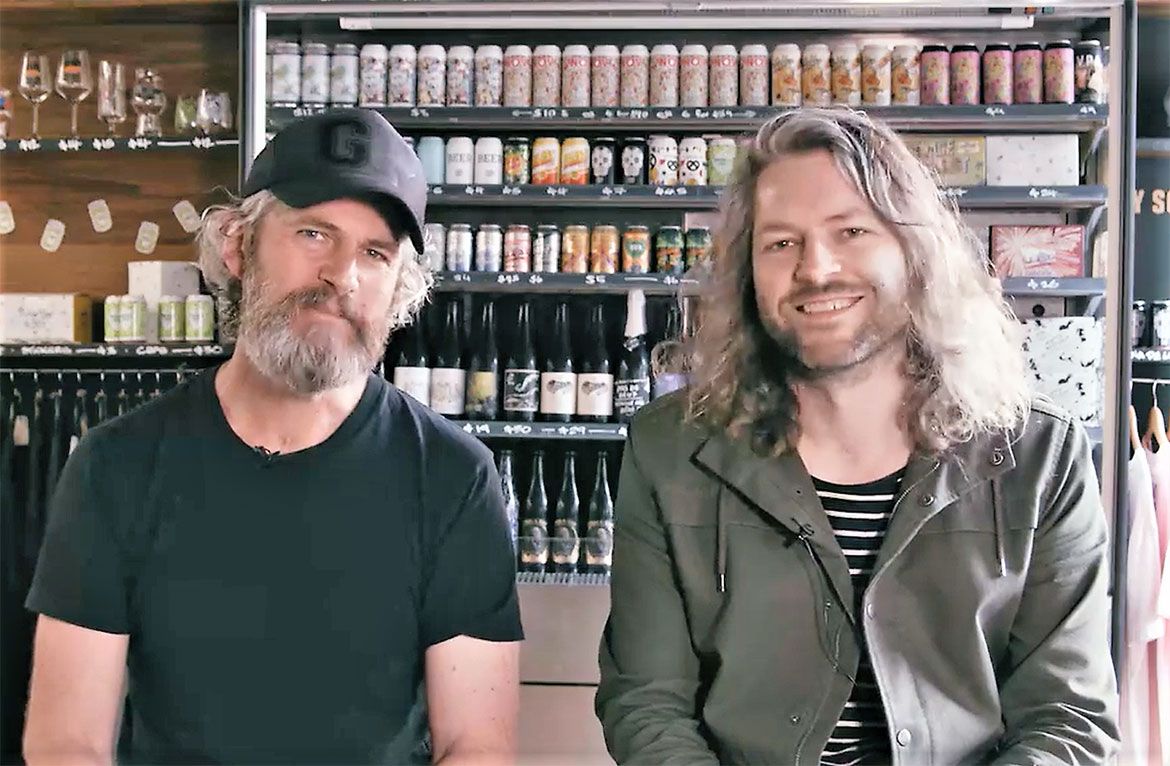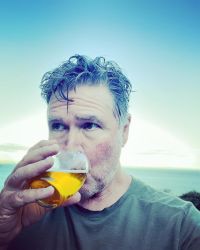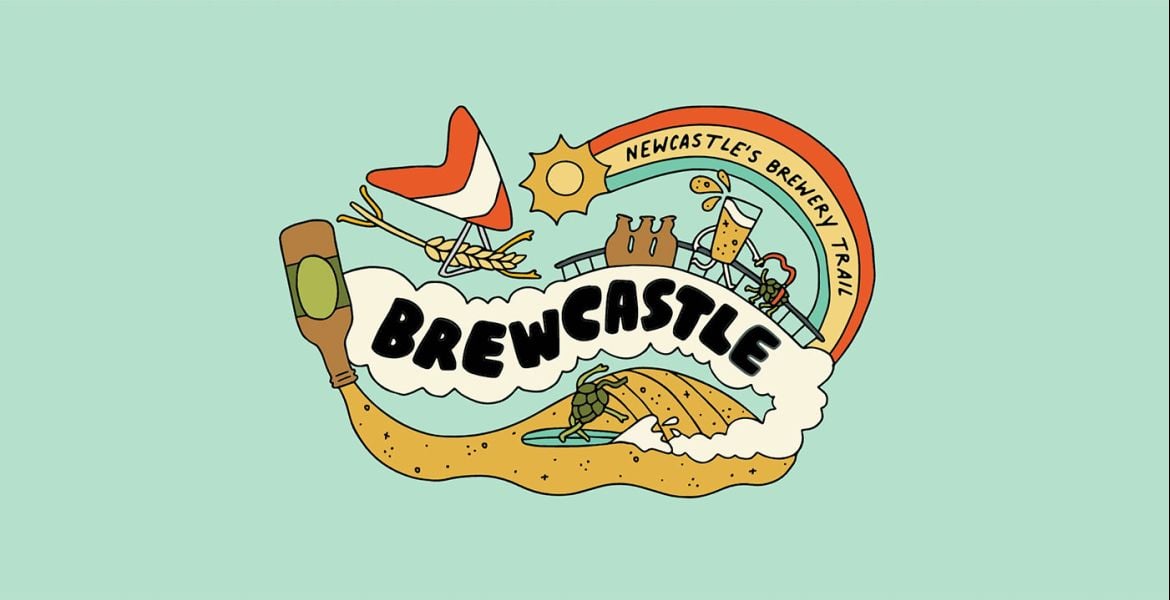Garage Project started life in a "derelict petrol station" in Wellington yet their origin story can be traced back further to regional New South Wales. As their 2023 Hāpi Symposium approaches, award-winning journalist and editor of Pursuit of Hoppiness, Michael Donaldson, takes us on a deep dive into their past, present and future.
One of New Zealand’s modern brewing legends could easily have been Australia’s.
In the late-1990s, Garage Project co-founder Pete Gillespie was living in the rural New South Wales village of Sunny Corner, about halfway between Lithgow and Bathurst.
"It was about 40km away from town and we were in the bush so if you ran out of beer you were stuffed," Pete says. "So, I started brewing for myself with a plastic bucket and tins of Cooper’s. That was the thin edge of the wedge.
"Beer is a funny thing, it really gets into your blood and brewing really gets under your skin – you just have to do it and I thought I was quite unique in thinking I didn’t want to pursue the career I was in and instead wanted to be brewer."
A trained journalist who still writes a lot of Garage Project’s beer descriptors, Gillespie went to Britain and worked his way up the brewing ladder before returning to Australia where he worked at Malt Shovel Brewery. But the further he went in brewing, the more interested he became in trying different things, which became difficult in a corporate-owned brewery.
The dream was to start his own brewery, and he wanted to build it in the Blue Mountains.
"I tried for three years to get it going but the bureaucratic hoops I had to go through were so mind-boggling that I eventually reached the end of my tether," he says.
"The Blue Mountains is such a magical spot – and I was so passionate about this brewery in the Blue Mountains – but I have never come across bureaucracy like what existed back then. The people I dealt with were lovely but there was no thinking outside the box."
When Gillespie took a trip to Wellington to visit his brother Ian he discovered a flourishing beer subculture but, weirdly, no breweries. The craft brewing boom had yet to start and Wellington’s only brewery, Mac’s, had stopped production on the waterfront.
Over a few beers with Ian and Ian’s lifelong friend Jos Ruffell, a plan was hatched to set up a brewery.
"The difference with New South Wales was like chalk and cheese," Pete says. "When I checked with the local council in Wellington they essentially said: ‘What a jolly good idea’."

It leaves you imagining, given the huge success of Mountain Culture, what Pete could have achieved had he been able to set up in his original dream location. But, equally, Garage Project would not be Garage Project without both Pete and Jos, a yin-yang combination of brewing creativity.
Instead of the natural beauty of the Blue Mountain, Pete’s first brewery home was instead a "graffiti-encrusted, rat-infested, derelict petrol station" in Aro Valley, a suburb of narrow, steep and shaded streets.
After cleaning up the site, the trio set up a small kit in the empty building and started brewing in August 2011. At the time, Garage Project was more a garage project, and other names were considered before the placeholder became the branding they were looking for.
Since their beginnings with the now legendary 24/24 series – 24 different beers in 24 weeks – GP have continued that pace, with 640 beers brewed in the less than 600 weeks they’ve been in business.
The pace has never relented and nor has the continual innovation.
"I often say that working at Garage Project is like running really fast down a steep hill," Pete says. "You know if you try to stop, you’ll come a cropper and it will fall apart – so you just keep running and trust."
The eclectic nature of their beer – from non-alcoholic, through simple lagers, to an array of IPAs, sours, wild ferments, wacky ingredients and wonderful collaborations – has seen them divide their business across three brewing sites: the original former petrol station handles the new and innovative traditionally-fermented beer; a massive contract brewery, bStudio, some 300km away in Napier looks after the high-volume, core range; and their Wellington central Wild Workshop produces lambic and gueuze style beers as well barrel-aged beers and some natural wine.
Many call Garage Project disrupters – entering a hazy East Coast IPA (Party & Bullshit) in the Malthouse West Coast IPA Challenge – is a classic example, but in a still-emerging craft beer scene, they are more like amplifiers.
Craft beer in cans? They weren’t the first, but when GP moved to cans, the rest of the Kiwi brew scene were dragged in their wake. Amazing artwork on cans? They were ahead of the curve and now everyone is following suit.
They weren’t the first craft brewery to produce a non-alcoholic beer, but their Tiny gets disproportionate attention and has increased the noise in the non-alcohol space. They made collaborations more than a brewery hook-up by pairing with popular chocolate maker Whittaker’s, Proper crisps, the New Zealand Ballet, theatre groups, festivals … and they are responsible for an entire city’s worth of restaurants making burgers during Wellington’s drawcard Wellington on a Plate, a month-long celebration of food and drink. And they’ve also released their own book, The Art of Beer, which featured their can art and posters.

On top of that, they run a tasting room at the Aro Street brewery, a separate taproom across and down the road in Aro Street, an occasional taproom at the Wild Workshop and another taproom in the Auckland suburb of Kingsland.
Plus, they self-distribute in New Zealand and Australia and also run Hāpi Research, a multi-party hop breeding and research business; Jos also has a side business called Phantasm.
Overseeing this maelstrom of activity is chief executive, Peter Fenton, and various divisional managers, but Pete and Jos remain the creative soul of the entire operation, a calling that they approach from different angles.
"Jos is fantastic at keeping his finger on the pulse of what’s going on – the trends," Pete says. "One of his skills is to sense what is happening long before it does.
"I spend zero time looking at what’s going on in the world of beer; I dislike knowing what’s happening because it’s distracting, disruptive – even if you’re actively not trying to borrow from other people, subconsciously it does happen. So, I try not to trawl the internet to see what is happening.
"Jos complements that by being all over it. Jos has been talking about things for years and quite often we roll our eyes and say, ‘He’s on about that again …’ and suddenly it becomes the hot thing. I’ve learned that if Jos is interested in something then you better pay attention."
The other complement to Gillespie is his brother Ian, who was part of the founding trio, but then went his own way before coming back to the GP fold, first in sales and then on the tools in the brewery. Unlike his brother and best friend, he holds no shares in the business.
"In the beginning, it was important to me that Ian didn’t get sucked into something I felt was my dream," Pete says. "Early on he was closely involved but I didn’t want him to be obliged to be part of GP because I could tell from an early stage it was something that was going to suck people in and take all their time and energy.
"So, he went away and came back and worked in sales and then he wanted to get on tools, so he joined the brew team and now he runs the brew team.
"Ian is a lot of things I am not. He’s very good at organising things and I’m incredibly chaotic. He’s very fastidious and has a lovely attention to detail. And when he makes things out of wood, they are remarkable pieces of exquisite beauty whereas I’m more cottage and roughshod.
"He’s a great counterpoint to me. I come in with chaotic creativity and Ian brings order to the chaos."
Pete says the innovation Garage Project is known for is, at heart, an extension of what’s been going on since "the beginnings of beer" – trying different things, playing with ingredients, different methods.
"What’s the point of just doing the same kind of thing? When we started, I felt it was incredibly important to do something remarkable, to distinguish us, not in a cheap way through stunts, but by being creative. If no one tried new things, we wouldn’t have the styles we have today."

As such, Pete is unapologetic if a beer offends someone – pleasing everyone is the middle-of-the-road route that leads to mediocrity. What does annoy him – and Jos – is when people claim they are style over substance, marketing over meaning. That’s partly because the marketing is so damn good – and in that sense having former Saatchi & Saatchi ad man Howard Grieve as their founding investor and chairman doesn’t hurt. But the proof of Garage Project’s success are the slew of awards, particularly in the past two years where they’ve been named New Zealand’s Champion Large Brewery at the NZ Beer Awards in successive years as well as taking out 2022's Champion Beer with their blended wild ale, Chance, Luck & Magic.
At last year’s New World Beer & Cider Awards, they had four beers in the elite Top 30. And they have 37 of the top 50 beers in New Zealand according to Untappd.
While the beer is the forward-facing canvas, behind the scenes is a complicated business network that includes a subsidiary company Brewwell Australia Ltd, which is registered on both sides of the Tasman, with the Australian registered office in Adelaide.
Jos says the plan to open a brewery in Australia is still on the cards. They released a video pre-COVID saying they were looking for an Australian site but COVID and, subsequently, the general state of the economy have hindered that search.
"Australia is very much on the cards," Jos says. "It’s just a combination of finding the right location and the right timing, given all the continued disruptions and interruptions – there’s definitely a lot of headwinds blowing at the moment."
They also self-distribute in Australia but with a slightly different portfolio than they have in New Zealand, brewing a small amount here or shipping them chilled to a cold-storage facility in Melbourne.
"We’ve got a team on the ground and a warehouse, cold room and head office in Melbourne," Jos says.
"We send a lot of one-off releases, speciality releases – our Fresh IPA is really popular over there – and we have a limited core range and it doesn’t resemble what we do in New Zealand. The main core beer is Golden Path, a 4 percent hazy IPA seems to work very well in Australia. Bliss Kiwi Lager is also popular and then, for some reason, Pickle Beer is very popular. Tiny is going well there as well."
This month, meanwhile, sees the return of the Hāpi Symposium at Wellington’s Te Papa Museum.
The first symposium was held in 2019 with plans for an annual event around the New Zealand hop harvest, but the pandemic put paid to the last three events. The event is designed for industry players and features an array of speakers, including Scott Janish from Sapwood Cellars, brewers from Stone and Other Half, and multiple hop growers (you can view the whole event here).
While it’s designed to be hop-focused, these days you can’t talk hops without talking about yeast – whether it’s thiolising yeast or hop biotransformation during fermentation – and two yeast specialists will present, including Garage Project’s own yeast scientist, Peter Bircham, as well as Laura Burns from Omega Yeast.
"We’re very lucky to have Peter," Pete says. "He’s working across a range of research and development projects, and capturing and identifying unique native New Zealand yeasts is right at the top for us. He’s set up a lab in partnership with Victoria University and we have some cool things in the pipeline."
That kind of intensive research and partnering with other organisations is typical Garage Project. They collaborate in more ways than beer.
The most obvious vehicle for this beyond-beer thinking is Hāpi Research Ltd, a joint venture between Garage Project and independent hop grower Freestyle Farms. Hāpi Research is supported by New Zealand’s Ministry for Primary Industries (MPI) and other partners include universities and American breweries Sierra Nevada and Hill Farmstead.
The main goals of Hāpi – the Maori word for hops – are to breed new varieties of New Zealand hops and open up new areas of hop-growing as well as enhance farming practices.
"The Hāpi umbrella includes precision farming, agriculture, drying, processing: like, how do we get the most out of the hops we have," Jos says. "And taking that a step further how do we maximise and unlock the flavour compounds in those hops, and that includes fermentation."
Hops have traditionally been grown in and around Nelson, at the top of the South Island, and for a long time all hop farms were part of the NZ Hops Ltd co-operative. Hop breeding research was done by the government body, Plant & Food.

That monoculture of breeding, selling and growing broke apart a few years ago and there are now a number of independent farms. Plant & Food are still aligned with NZ Hops Ltd, but not exclusively, and that partnership has released two new hop varieties in the past three years – Nectaron and Superdelic – which took 17 and ten years respectively to reach commercialisation.
Hāpi is five years into the project, which was funded for seven years, and Jos is hopeful of having a new hop variety released within that time frame.
"We do have one we’re pretty excited about and we’re hoping from this harvest to get a decent quantity for trial brewing and then to expand the acreage … we’re doing everything we can to short-circuit the process."
Moving out of the Nelson area is also a big part of a terroir puzzle, which fascinates Jos, and Garage Project have a financial stake in a farm in the Nelson Lakes region, an area that is at a higher altitude than Nelson and is hotter in summer and colder in winter.
Another area proving itself is Southland, the most southern part of the South Island, where five years ago nobody would have predicted hops would grow successfully but where Garage Project are helping Garston Hops with their fledgling farm there.
"One of our mandates or goals with Hāpi was to expand the hop growing regions," Jos says. "We don’t have a financial stake in Garston, but we’ve been heavily supporting them since they started, providing initial varieties for them to do trial growing.
"Freestyle has been incredibly involved in advice and guidance and we have created a mobile picker that we’ve made available to them. And we’re advising with trial brewing and market advice. We’re stoked to see what’s happening down there."
Jos says any region or grower can be involved in the Hāpi Project.
"Hop growing is hard and expensive, but for any region or grower who wants to have a crack at it, we’ve been building resources to support and encourage them," he says. "And Hāpi is completely agnostic around the business model they choose – if they wanted to sell hops through NZ Hops Ltd, an independent farm or form a relationship with someone overseas, we’re encouraging all of it."
He says the hops grown in Southland are noticeably different thanks to the climate and soil.
"There’s definitely a difference, and definitely varieties that will perform better (or worse), just the way Central Otago is sealed into pinot noir or dry riesling, it’s going to the same with hops: certain varieties will perform better than others. It’s too early to say for sure as this is the first proper harvest, with baling and drying, so we’ll get a proper snapshot this year."
Garage Project do have a financial stake in a "huge project" – a new farm in Nelson Lakes. It’s a converted dairy farm that sits on up to 400 hectares in the Tutaki Valley near Murchison. So you can now add "hop farmer" to their vast list of skills.
It would have been wonderful for the Blue Mountains and Australia if Pete Gillespie could have set up his brewery in that part of the world, but it was probably essential for Wellington and New Zealand that they set up on that side of the Tasman, because it’s not an understatement to say they have single-handedly changed the beer culture across The Ditch.
Tickets to the Hāpi Symposium are still available and you can buy them here.
Meanwhile, as part of The High Country Hop in Beechworth this month, The Crafty Pint team is MCing a Technical Symposium on March 24; details here.




















